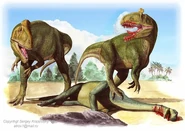| Cryolophosaurus Temporal range: Early Jurassic | |
|---|---|
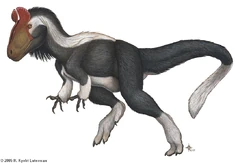
| |
| An artist's illustration of Cryolophosaurus ellioti | |
| Scientific classification | |
| Kingdom: | Animalia |
| Phylum: | Chordata |
| Superorder: | Dinosauria |
| Order: | Saurischia |
| Suborder: | Theropoda |
| Genus: | †Cryolophosaurus Hammer & Hickerson, 1994 |
| Species: | †C. ellioti |
| Binomial name | |
| †Cryolophosaurus ellioti Hammer & Hickerson, 1994 | |
Cryolophosaurus (meaning "cold crested lizard") was a large theropod dinosaur, with a bizarre crest on its head that looked like a Spanish comb. Due to the resemblance of this feature to Elvis Presley's pompadour haircut from the 1950s, this dinosaur was at one point informally known as "Elvisaurus". Cryolophosaurus was excavated from Antarctica's Early Jurassic (Pliensbachian stage) Hanson Formation (former the upper Falla Formation) by paleontologist Dr. William Hammer in 1991 and named in 1993.
It is the first carnivorous dinosaur to be discovered in Antarctica and the first dinosaur of any kind from the continent to be officially named. Dating from the Early Jurassic Period, it was originally described as the earliest known tetanuran, though subsequent studies have found that it is probably a dilophosaurid. Nesbitt (et al., 2009) using the characters of Tawa found it to be a neither dilophosaurid nor averostran neotheropod but the sister group of a clade composed of dilophosaurids and averostrans. Cryolophosaurus was about 6 to 8 meters (20 to 26 feet) in length, which was far smaller than Allosaurus, which grew to a maximum of 12 meters (40 feet) long.
Odd Skull Design[]
A high, narrow skull was discovered, 65 centimeters (25 inches) long. The peculiar nasal crest runs just over the eyes, where it rises up perpendicular to the skull and fans out. It is furrowed, giving it a comb-like appearance. It is an extension of the skull bones, near the tear ducts, fused on either side to horns which rise from the eye sockets (orbital horns). Other carnivores like Monolophosaurus usually have crests that run along their skulls, while others, such as Ceratosaurus or Carnotaurus, have large horns sticking above their skulls.
Discovery and naming[]
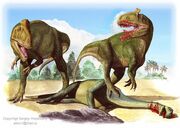
Cryolophosaurus has killed a Glacialisaurus, as another approaches and tries to get a bite out of.
Cryolophosaurus was originally collected during the 1990-91 austral summer, by William R. Hammer and his team, on Mount Kirkpatrick, in the Beardmore Glacier region of the Transantarctic Mountains. They were located in the siliceous siltstone of the Hanson Formation (formerly the upper Falla Formation) and dated to the Pliensbachian stage of the early Jurassic. In 1991, both Hammer and the Ohio geologist David Elliot had excavated separate outcroppings near Beardmore Glacier, sharing logistical expenses. Elliot’s team first came across the remains of Cryolophosaurus in a rock formation (altitude 13,000 feet (4,000 m) and 400 miles (640 km) from the South Pole), and notified Hammer. Over the next three weeks, Hammer excavated 5,000 pounds (2300 kg) of fossil-bearing rock. The team recovered over 100 fossil bones, including those of Cryolophosaurus. The remains included part of a partially-crushed skull, a jaw bone (mandible), parts of the backbone (30 vertebrae), hip bones (the ilium, ischium, and pubis), leg bones (femur and fibula), an ankle bone (tibiotarsus) and foot bones (metatarsals). These specimens were formally named and described in 1994 by Hammer and William J. Hickerson, in the journal Science. The name Cryolophosaurus ellioti was dervived from the Greek κρυος (meaning ‘cold’ or ‘frozen’), λοφος (meaning ‘crest’) and σαυρος (meaning ‘lizard’). Hammer and Hickerson named the species C. ellioti after David Elliot, who had made the initial discovery of the fossils.
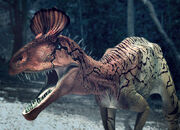
Dinosaur Revolution Cryolophosaurus
Description[]
The holotype FMNH PR1821 is the only fully described specimen of Cryolophosaurus. The specimen consists of an incomplete skull and mandibles lacking most of their front half; nine maxillary teeth; a fragmentary sixth cervical centrum; cervical vertebrae 7-10; several posterior cervical ribs; several anterior dorsal vertebrae; most mid and posterior dorsal vertebrae; several dorsal ribs; the fifth sacral vertebrae; three chevrons; many partial and complete caudal vertebrae and centra; two partial humeri; a proximal radius; a proximal ulna; a partial ilium; a proximal pubis; both ischia, but only one distal; two incomplete femora; the distal end of a tibia; the distal end of a fibula, and the astragalus and calcaneum. In 2013, new material of Cryolophosaurus was unearthed in Antarctica. The description of this material has not yet been published in a non-abstract form.
Cryolophosaurus was a large, well-built theropod, one of the largest of its time. The genus has been described by Roger Benson and colleagues (2012) as a top predator in Antarctica. It had slender proportions. Cryolophosaurus was estimated as being 6 to 7 m (19.7 to 23.0 ft) in length by William R. Hammer & William J. Hickerson (1999). A 2007 study by Nathan Smith et al. revised the length to 6.5 m (21.3 ft). Its weight estimated at 465 kilograms (1,025 lb). Based on these length and weight estimates, Cryolophosaurus is currently the largest known Early Jurassic theropod. Smith et al. (2007b) and Benson et al. (2012) noted that the holotype individual probably represents a sub-adult, so adults could have been larger. In 2016 Molina-Pérez and Larramendi gave a larger estimation of 7.7 meters (25.3 ft) and 780 kg (1.720 lbs).
Classification[]
Classification of Cryolophosaurus is difficult because it has a mix of primitive and advanced characteristics. The femur has traits of early theropods, while the skull resembles much later species of the clade Tetanurae, like China's Sinraptor and Yangchuanosaurus. This led Paul Sereno et al. (1994) to place Cryolophosaurus in the taxon Allosauridae. Originally, Hammer and colleagues suspected that Cryolophosaurus might be a ceratosaur or even an early abelisaur, with some traits convergent with those of more advanced tetanurans, but ultimately concluded that it was itself the earliest known member of the tetanuran group. While a subsequent study by Hammer (along with Smith and Currie) again recovered Cryolophosaurus as a tetanuran, a later (2007) study by the same authors found that it was more closely related to Dilophosaurus and Dracovenator. Sterling Nesbitt et al. (2009), using the characters of Tawa found Cryolophosaurus to be neither a dilophosaurid nor averostran neotheropod but instead the sister group of a clade composed of dilophosaurids and averostrans. However, in 2012, Matthew Carrano found that Cryolophosaurus was a tetanuran, related to Sinosaurus, but unrelated to Dilophosaurus. In 2020, a monograph of Dilophosaurus found Cryolophosaurus to be a derived neotheropod, close to Averostra, in a more derived position than Zupaysaurus, but less than Dilophosaurus.
Paleobiology[]
Cranial display features, such as the one possessed by Cryolophosaurus, make sense in social, gregarious animals, where other members of the species are available to observe and interpret messages of sexual status. Kevin Padian et al. (2004) challenged conventional hypotheses that the purpose of bizarre cranial structures and post-cranial armor in dinosaurs, was either for attracting mates, intimidating/fighting rivals in the group, or intimidating potential predators of other species. Padian et al. noted that based on phylogenetic, histological, and functional evidence these bizarre structures can be explained by the phenomenon of intra-species recognition, which is supported by the fossil evidence. Thomas R. Holtz Jr. (2010) found that the bizarre crest of Cryolophosaurus was primarily for intra-species recognition, based on evidence from related species and studies of bone texture. According to Thomas Rich and his colleagues, the crest would have been ineffective as a weapon and may have possibly functioned as a display feature during certain types of social behavior such as mating. In 2019, a species recognition function was disputed but a socio-sexual display structure model was suggested.
When the type specimen was discovered, several long cervical ribs, of a supposed prosauropod dinosaur were found in the mouth of Cryolophosaurus, which led Hammer (1998) to conclude that it was feeding on the prosauropod when it died. Hammer further noted that since the ribs were found extending all the way back to the theropod's neck region, this individual may have choked to death on these ribs. However, Smith et al. concluded that these remains belonged to the Cryolophosaurus specimen itself, and not to Hammer's "prosauropod". Hammer also concluded that a post-canine tooth belonging to a tritylodont (an early mammal relative), found with the remains, was part of its stomach contents when it died.
Some Cryolophosaurus bones have pathologies that show evidence of scavenging. Broken teeth from a juvenile Cryolophosaurus were found nearby. These teeth have no roots and likely shed naturally while scavenging the adult Cryolophosaurus carcass.
Another possible pathology is found in the astragalus (ankle bone) of Cryolophosaurus. This bone was preserved with a small splint from the fibula located just above the ankle. The splint, however, may also be just a unique morphological feature of Cryolophosaurus.
Paleoecology[]
All known specimens of Cryolophosaurus have been recovered in the Hanson Formation, which is one of only two major dinosaur-bearing rock formations found on the continent of Antarctica. It was discovered in "tuffaceous" siltstone deposited in the Sinemurian to Pliensbachian stage of the Early Jurassic, approximately 194 to 188 million years ago. This geological formation is part of the Victoria Group of the Transantarctic Mountains, which is approximately 4,000 metres (13,000 ft) above sea level. The high altitude of this site supports the idea that early Jurassic Antarctica had forests populated by a diverse range of species, at least along the coast. The Hanson Formation was deposited in an active volcano−tectonic rift system formed during the breakup of Gondwana.
In the Early Jurassic, Antarctica was closer to the equator and the world was considerably warmer than today, but the climate was still cool temperate. Models of Jurassic air flow indicate that coastal areas probably never dropped much below freezing, although more extreme conditions existed inland. Cryolophosaurus was found about 650 kilometres (400 mi) from the South Pole but, at the time it lived, this was about 1,000 km (621 mi) or so farther north. This formation has produced the remains of Glacialisaurus (a large basal sauropodomorph), a crow-sized pterosaur (a dimorphodontid), a synapsid (a tritylodont, which is a type of synapsid about the size of a rat), herbivorous synapsid, and two small unnamed sauropodomorphs. There are also the remains of many plant genera recovered from the Early Jurassic Camp Hill Formation, around the same age as fossils of Cryolophosaurus, proving that dense plant matter had once grown on Antarctica's surface before it drifted southward.
In the media[]
- Cryolophosaurus appears in the first episode of Dinosaur Revolution. In the episode, as a mated pair look on their eggs a larger male appears and he attacks the resident male and eats the eggs. It later appears planning an attack on a lone Glacialisaurus. He tries to ambush, but the Glacialisaurus fell down the log the Cryolophosaurus chased its prey on and into the mud. As the Cryolophosaurus is being assaulted by a flock of giant mosquitoes, it runs towards a herd of Glacialisaurus, chasing off the dominant male. However, the lone Glacialisaurus survived, covered in hard mud that is mosquito-proof.
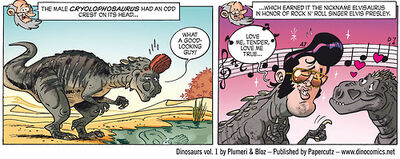
Cryolophosaurus in Dinosaurs:In The Beginning
- Cryolophosaurus also appears in both Primal Carnage and Primal Carnage: Extinction. It has the ability to spit out poison in Primal Carnage, where it is simply an alternate skin for the Dilophosaurus in the game. It instead spits out acid in the sequel, Primal Carnage: Extinction.
- Cryolophosaurus appears in Warpath: Jurassic Park as one of the six unlockable dinosaurs. It can be unlocked after Triceratops, and right before Albertosaurus. Its move pattern was the same to that as Tyrannosaurus rex and Acrocanthosaurus. It has fast but weak attacks and combos. However, instead of biting, this Cryolophosaurus uses its crest to attack. It has 3 different colors: black, light orange, and green.
- Cryolophosaurus appears as a mob in both the PaleoCraft and Orespawn Minecraft mods.

Cryolophosaurus as it appears in Orespawn
- Cryolophosaurus appeared on Dinosaur Train, the individuals are King and Crystal.
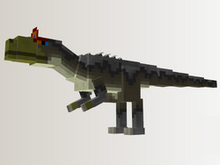
PaleoCraft Cryolophosaurus
- Cryolophosaurus also appeared in Dinosaur King.
- Cryolophosaurus appears in dinosaur world mobile,which appeared in Christmas update.
Galley[]

Cryolophosaurus Battle - Reign of the Dinosaurs

